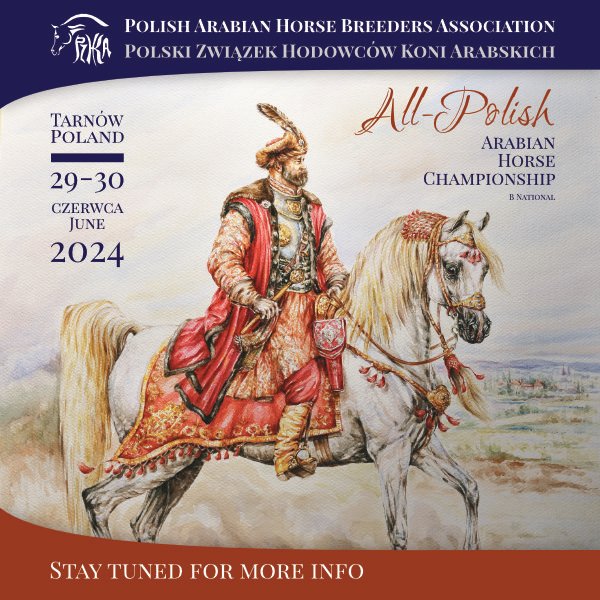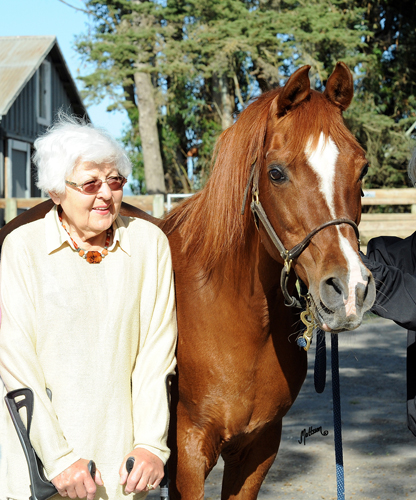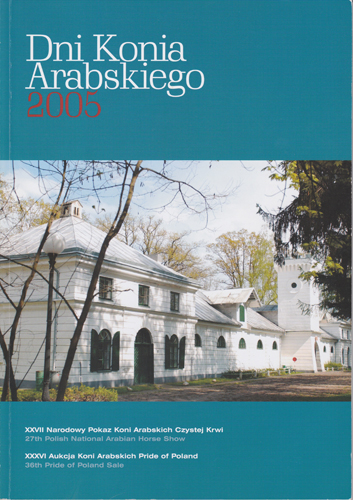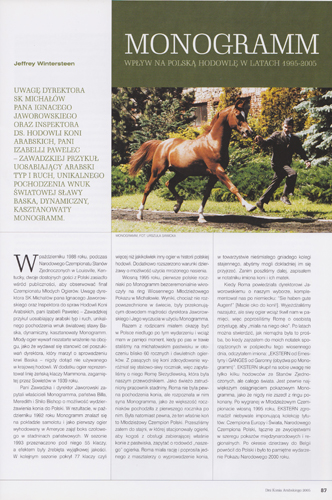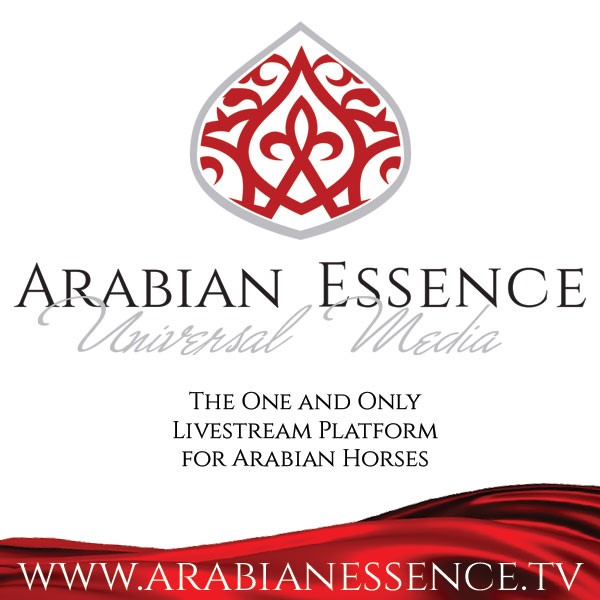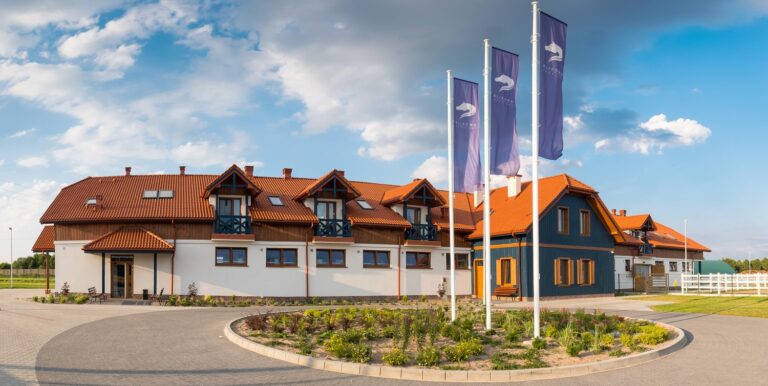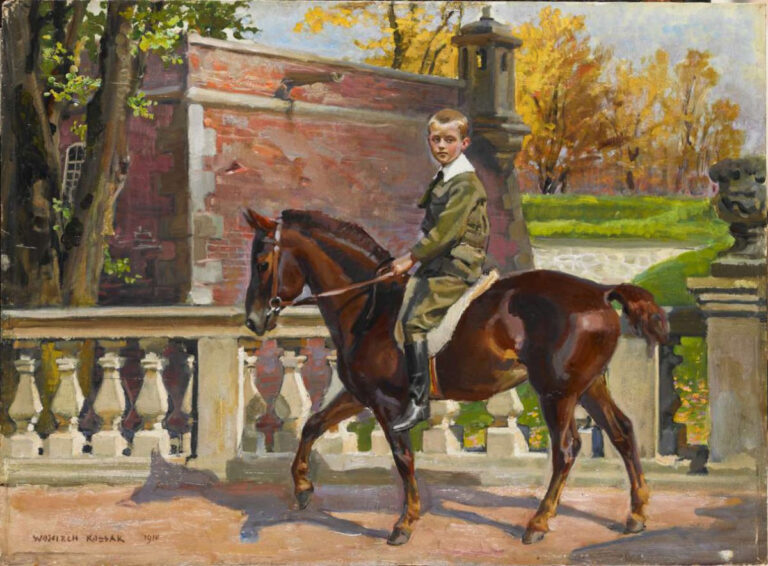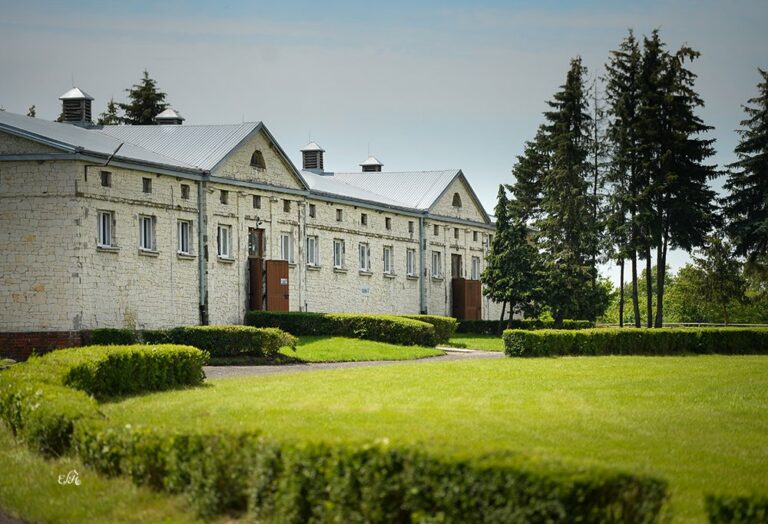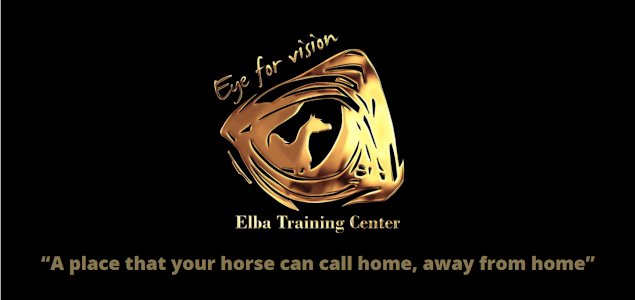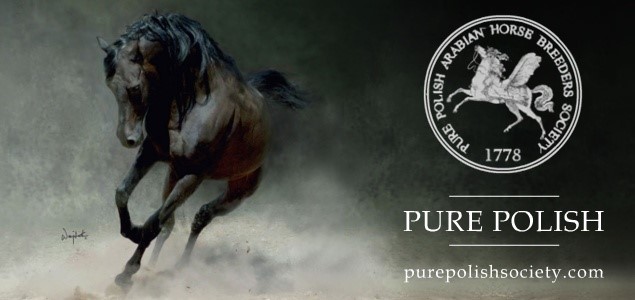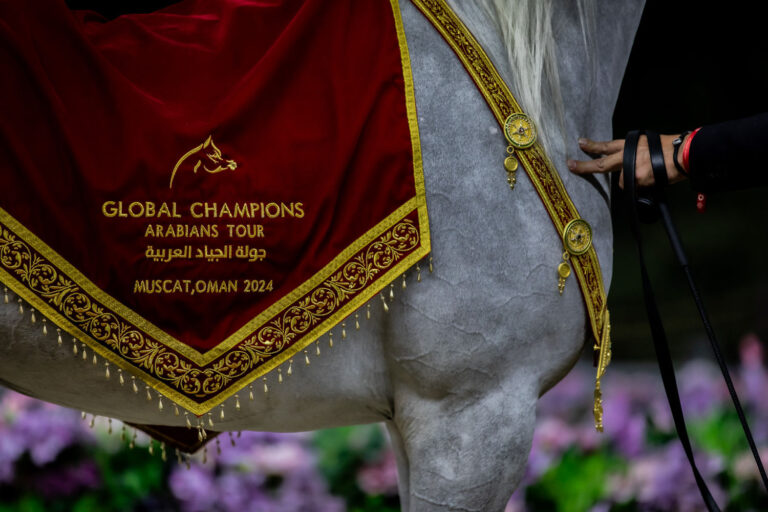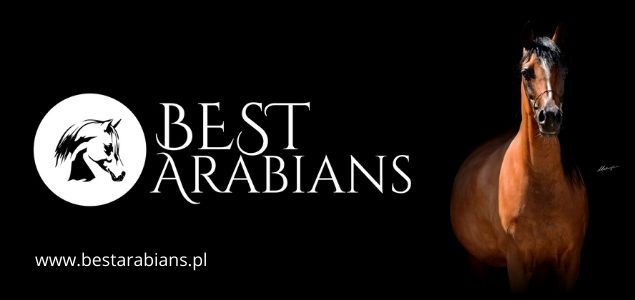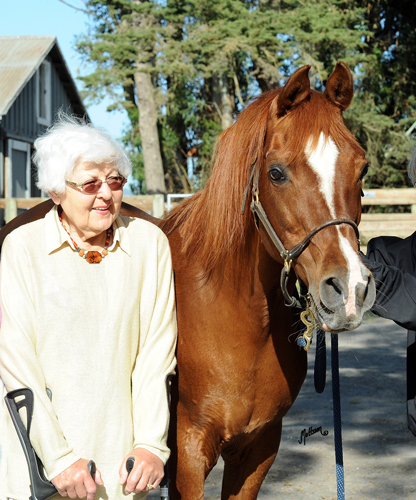
So many horses are referred to today as “living legends“ that this phrase has lost its former glamour. However there is a stallion which fully deserves this accolade. This stallion is MONOGRAMM, whose daughters brought fame to modern Polish breeding and whose sons have made a lasting impact on breeding worldwide.
The 29 year old (today) son of Negatraz and Monogramma, grandson of Bask and Knippel, great-grandson of Witraż and Priboj and a descendant of the imported from the desert to Poland in 1931 Kuhailan Haifi, is a hero of numerous stories, anecdotes and recollections, whereas the time of his being active at stud is often referred to as “the Monogramm era“. His ancestors wrote themselves down in history and have their own monuments, both metaphorically and literally – the larger-than-life statue of the Albigowa-bred Bask, cast in bronze by sculptor Edwin Bogucki, stands in the hall in front of the entrance to the Kentucky Horse Park (USA). Monogramm‘s descendants are creating history till this day – names such as Ekstern, Kwestura, Ganges, Emmona and Fallada are known to all Arabian horse aficionados. It is hard to imagine what modern Polish Arabian horse breeding would look like today without Monogramm.
From the Pattersons to the Bishops. From Bishop Lane Farm to Michałów
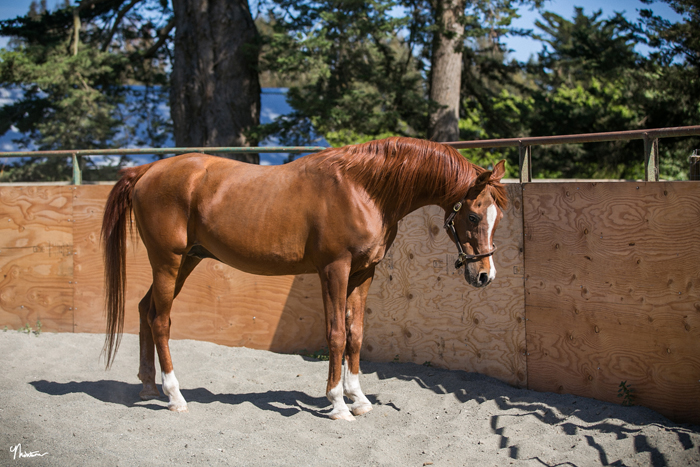
Monogramm was born in 1985 at the stud of Kay and Richard Patterson, American breeders who frequently visited Poland and one of the few foreigners brave enough to peep behind the Iron Curtain in the communism era. Kay Patterson recalls (1*): „For Richard and me, the journey with Director Jaworowski and his charming and gracious wife Maria began in June of 1968 on our first trip to Poland. This would be followed by at least one trip annually for over 20 years in search of knowledge and breeding stock (the importation of over 100 horses) for Patterson Arabians in Sisters, Oregon. (…) Ignacy immediately recognized that we were students with an insatiable thirst for learning about the old Polish horses, their pedigrees, and how to cross the various lines. He shared willingly from his great store of archive photos, books, and practical knowledge. He also spoke openly and honestly of his successes and failures with various bloodlines and specific horses – this often done over a snack of chocolate cookies and vodka. (…) Just as we spent time in their home, Ignacy and Maria were guests in our home on a number of occasions throughout the years. He delighted in these times as he was personally able to see the magical results of some of the influence of his mentorship. Ignacy loved Negatraz and thought him to be the best bay, pure Polish breeding son of Bask“. The Pattersons were willing to send Negatraz for two seasons to Poland, but in the face of political upheavals in Poland in the early 80s (first Solidarity, later martial law) it just wasn‘t possible. In 1983 the Pattersons paid 250 thousand dollars for the star of Make Believe Farms (owned by Bob Stratmore) – a granddaughter of Mammona, who as a foal was robbed from Janów Podlaski and taken to Tersk, the 18 year old Monogramma (Knippel – Monopolia/Priboj), in order to breed her to Negatraz. „The first born of 4 full siblings was Monogramm, an outrageously beautiful chestnut colt“, Kay Patterson recalled. “He was sold at one year of age to the Bishop family, in California, who were looking for a world class colt. Ignacy saw him a few years later with Iza Zawadzka and knew that he needed Monogramm at Michałów. Thanks to the generosity of Bill and Meredith Bishop, our fantasy was vicariously and prophetically fulfilled. (…) Even after Monogramm‘s return to the USA, Ignacy had the foresight to continue to breed to him with shipped semen. The rest is history. Monogramm daughters and sons bred by Director Ignacy Jaworowski have brought fame and fortune to Michałów State Stud since Poland‘s independence, winning championships in every country in which they have been shown, the world over. Both Ignacy and Andrzej Krzyształowicz told us many years ago that such a breeding stallion comes along perhaps once in every 50 years. My proudest moment as a breeder was returning to Poland and watching with my special friends, Ignacy and Maria Jaworowski, Andrzej
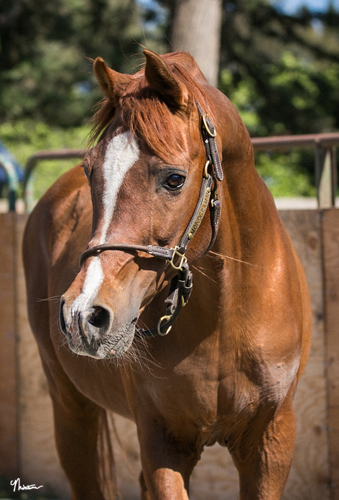
Krzyształowicz, Izabella Zawadzka and Roman Pankiewicz as five Monogramm daughters, all bred by Michałów, took first through fifth place in the Two Year Old Filly Class at the 1997 Polish National Show. I do not recall ever having seen the get of one sire take all of the places in any given class at the Polish National Show. To be the breeder of such a sire is a special blessing. That day was a gift I shall never forget.“
A great advocate for bringing Monogramm to Poland was Mrs. Izabella Pawelec-Zawadzka, at the time a horse inspector in the Horse Breeding Department at the Ministry of Agriculture, today an honorary president of the PAHBS. She saw him for the first time in the US in October 1988 during the US Nationals in Louisville, KY. She went there together with Director Jaworowski. Mrs. Zawadzka recalls: “Even now I have him before my eyes. That glint that accompanied him. Both our jaws dropped! At the time Monogramm was a three year old colt and it was immediately visible that he had a unique personality and expression. When you start to “take a horse apart to pieces” you begin to see his faults. A perfect horse doesn‘t exist. But it is that first impression that counts. Monogramm had this incredible fire and power. When he entered the arena, he owned it. He was very impressive, of a chestnut, slightly reddish coat color. He appeared to be on fire. And those large, dark eyes. He was so interested in his surroundings, so happy. And he was a fabulous mover. The Americans did not value good movement and oftentimes even tried to conceal it. But he made a royal entrance and that‘s what caught our attention. Already then Director Jaworowski, a visionary, great breeder and wonderful person, said: “I have to have him.”. He knew that the colt would turn out to be a great stallion.“
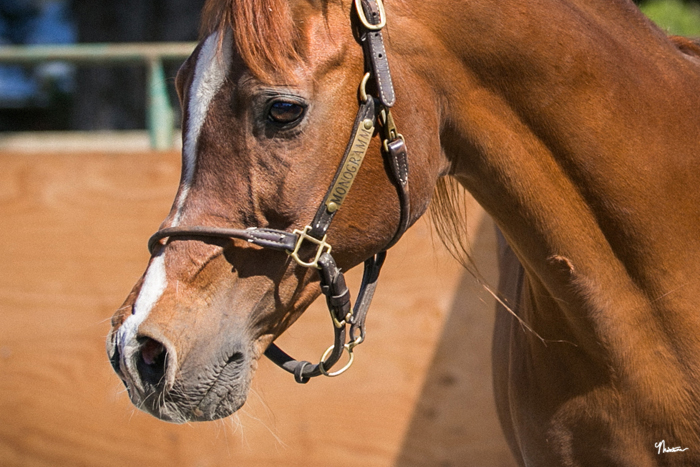
Though the idea to bring Monogramm to Poland dawned upon Director Jaworowski at that very moment, it was possible only 5 years later. “First of all we had to wait until the horse matured“, explains Mrs. Pawelec-Zawadzka. “Back then such young horses weren‘t used for breeding, they had to be at least 4 years old. Apart from that the Bishops were very wealthy and rather inaccessible. Just getting close to them enough to speak to was a huge challenge. Bill Bishop was happy that he had Monogramm, he wasn‘t considering selling or leasing him. He didn‘t want to hear about it. We were able to obtain the stallion thanks to two people: Tomasz Skotnicki and Dale Sause of Maplewood Arabians in Oregon. Thanks to the recommendations of our American friends Mr. Bishop agreed to meet with us in Scottsdale. He was very distrustful, we didn‘t know how to start, everything required a lot of diplomacy. But we began talking and later corresponding with each other. With time our friendship grew.“
Before Monogramm found his way to Poland he managed to acquire quite a number of titles, including 1988 US National Futurity Reserve Champion and 1991 & 1992 US National Top Ten Champion Stallion.
A new era begins
Monogramm, a handsome stallion with a beautiful head and neck, dark eyes, good body, made the biggest impression with his superb movement. He was used at Michałów for two seasons (1993–1994). During 1995–1997 he was used in the Polish breeding program via frozen semen. In total he was bred to a record number of 167 mares. His first crop consisted of 52 get (23 fillies and 29 colts), the second – 46. Later he was also used by the few at the time Polish private breeders. All in all he sired 112 foals: 54 colts, 58 fillies of grey, chestnut and sometimes bay coat colors. “Foals by this sire have excellent type and presence, a small beautiful head, highly set swan-like necks, solid build, strong quarters and superb movement“, wrote Izabella Pawelec-Zawadzka in 1994 (2*).
Already his first crop heralded significant changes in Polish breeding, though few presumed that they were witnessing the beginning of a new era. Jeffrey Wintersteen (today of “Arabian Horse World“) wrote in 2005 (3*) „In the spring of 1995 at Michałów Stud, the first of the Monogramm foals in Poland unceremoniously entered the show ring for the Junior Spring Show. The results, while unheralded internationally, were convincing evidence of Director Jaworowski‘s wisdom to lease Monogramm. My parents and I were fortunate to visit Poland shortly after the show, and I still have a clear vision of standing in the colt pasture at Michałów, waist deep in grass and surrounded by some 60 yearlings and two year old colts. A steel grey was an absolute standout (…) We were so taken with the colt we actually waited around the barn for the grooms to bring the colts in from the pasture so we could verify his pedigree“. The colt, Wintersteen continues, was finally led into the stable accompanied by a shy bay. The American visitor wrote their names down in his notebook. After several years this note turned out to be a herald of a new era. The note read: „Ekstern out of
Ernestyna and Ganges out of Garonna (both by Monogramm)“. „Monogramm, like Eukaliptus before him, has made a lasting impact on the Polish Arabian. Monogramm can certainly be credited with enhancing an exotic type, tremendous neck sets, phenomenal motion and perhaps most important, an undeniable show ring presence“, summed up Wintersteen.
The Junior Spring Show of 1995 (organized then at Michałów) brought titles for Ekstern and Ganges: Champion and Reserve Champion. The 1996 show was a triumph of sons and daughters of Monogramm, including Fallada (champion) and Zagrobla (reserve). Furiat (out of Furora by Pepton) became champion, Ganges was the reserve. Monogramm‘s get continued their victorious march during the Polish Nationals at Janów. Kwestura and Zagrobla claimed the titles of champion and reserve. And later his heirs went on to conquer Europe and the rest of the world…
So numerous is the Polish get of Monogramm that shined on arenas worldwide that it would be impossible to list all of his famous daughters and sons. Only in Poland they claimed the Polish National championships several times. The title of Polish National Senior Mare was awarded to: Ekscella (2001), Fallada (2003), Palmira (2007) and Emmona (2011). Apart from Ekstern and Furiat also Erbil (1997) was crowned Polish National Junior Champion Stallion. In the senior championships victorious were: Ekstern (2000) and Ganges (2001). Now let‘s focus on those horses which without exaggeration can be said that just like their sire they are “living legends“.
The invincible Ekstern
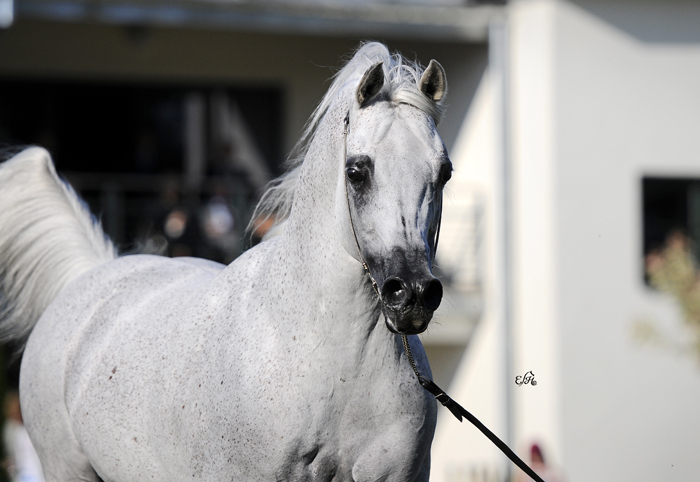
He was born in Monogramm‘s first Polish crop and turned out to be his most titled son, unbeaten on the arena, as he won all the shows he starred in, claiming among others the All Nations Cup in Aachen, as well as the European and World Championships. He won them while on lease to Christine Jamar of Jadem Arabians (Belgium), where he stood during 1999–2000. But he caused a surprise already in Poland, when as a dark grey, foal-like yearling, in the hands of the debuting Mariusz Liśkiewicz, he won the Polish National Junior Championships (1995). Liśkiewicz was at the time at the threshold of his career as both trainer and handler. It was his first success on the show arena. „At the time there were such great trainers and handlers as Tadeusz Wojtal, Scott Benjamin, Krystyna Podlejska, Lucjan Kulczyński“, he reminisced (4*) “We were showing more than a dozen colts. (…) The inconspicuous Ekstern, considered first to get the axe, was given to me at random. I did not train him for the shows and prior to Białka I had him perhaps five times in my hand. We ran onto the arena. He stopped somehow. How I accomplished that, I don’t remember. He moved remarkably, I tried not to interfere and all the judges gave him 20s for movement. The competition was extremely strong, and still he won. That’s when something hit me: maybe I will be doing this!“. Ekstern‘s later successes on European arenas were claimed with Dutchman Erik Dorssers, who showed him fabulously during the unforgettable evening of the Mercedes Diamond Cup 2003 (Borgloon, Belgium). As Mrs. Pawelec-Zawadzka recalls, the pair had a tremendous bond with each other and the silvery, almost fairy tale like Ekstern was simply having fun, causing general admiration with his superb movement. Let loose, he still trotted alongside his handler, as though they were connected by an invisible rope. Such an understanding between man and horse is an extremely rare sight!
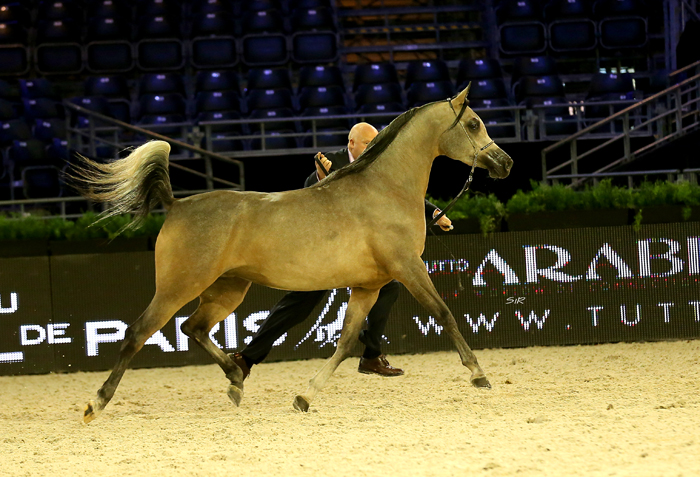
After his return from the lease Ekstern was widely used not only by the state studs, but also by private breeders. “It is no wonder that breeders looked towards this stallion. He had great Arabian type, an exotic head, wonderful movement, and what‘s most important – he was a stallion that had just claimed the most prestigious trophies and was well known to breeders (including potential buyers of his get) all over the world“, we wrote on polskiearaby.pl (5*). Today Ekstern covers few mares, though he‘s not retired just yet. In the 2014 season at Michałów 8 mares were covered and other 22 breedings sold. He has been succeeded mainly by his highly titled son Esparto (out of Ekspozycja by Eukaliptus), sire of Perfinka, who leased by Al Muawd Stud (Saudi Arabia) took the European and world show arenas by storm. Other notable mentions of Ekstern‘s world-famed get include Palanga, Sefora and Altamira. Private breeders also benefitted from his genetics, having bred multiple champions Psyche Victoria and Psyche Kreuza (both from Chrcynno-Palace Stud) or Szanta (bred by Bogusław Dąbrowski, sold at the Pride of Poland Sale 2014 to Germany) and Eksterna from Falborek Arabians. Ekstern‘s daughters enjoy huge interest at the Janów Podlaski sales. This year Cenoza was sold to Halsdon Arabians (UK) for 240 thousand euro. In 2007 Laverna sold for 140 thousand Euro to Dubai; the private-bred (StanRed Arabians) Bellissima achieved 80 thousand Euro in 2008 and headed for Saudi Arabia, while Ekina changed owners for 100 thousand Euro and went to Belgium. During that same auction Polish buyers (Mr. & Mrs. Pietrzak) paid 65 thousand Euro for Dormeza. Droga Mleczna in 2009 headed to the Middle East for 67 thousand Euro, similarly to Felicjana who brought in 105 thousand Euro. But the record price was achieved
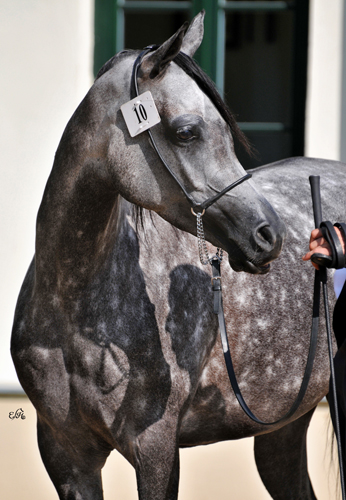
in 2009 by Pinta, for whom Shirley Watts (Halsdon Arabians) offered a round 500 thousand Euro! With that Pinta remains the highest sold Ekstern daughter so far. In 2010 Wilga was sold to Belgium for 82 thousand Euro. The black Sarbia went to Halsdon Arabians in 2011 (85 thousand Euro) and Biruta joined her friends in the UK in 2012 for 100 thousand Euro. Also in 2012 the private-bred Gataka (Bełżyce Arabians) achieved 55 thousand Euro and travelled to the Middle East.
Ganges – beauty and stamina
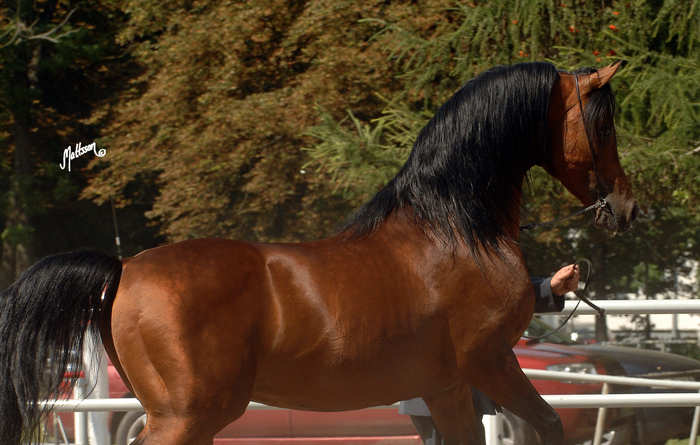
Ganges, very charismatic, of a beautiful, dark bay coat color and abundant, rebellious mane, is one of those horses that have avid fans worldwide. He is the one that most resembles Bask, whose bloodline and type was to be introduced into the Polish breeding program by Monogramm. “He is the embodiment of a true Polish Kuhailan, combining beauty with stamina“, we read in the previously quoted article (6*) “His athletic build, which he no doubt inherited from his Oaks winning dam (Garonna by Fanatyk), allowed him to achieve a high coefficient of success (3.0). Being on a three year lease to the US (2002–2004) he claimed not only the title of US National Reserve Champion, but also a Top Ten Country English Pleasure in Scottsdale, confirming that he is not just handsome, but also a great performer under saddle. Though in comparison with Ekstern he has not sired much get in Poland, the foals that have been born are of a great quality. Attesting to that are record prices achieved at auctions, starting with the sensational sale (as Lot 0) of Wieża Wiatrów for 220 thousand Euro to Saudi Arabia (2002 – she won the Polish National Reserve Champion Mare title the previous day), through Zulejka (205 thousand Euro, Belgium), Złota Wieża (2007, 85 thousand Euro, Belgium) up to the black Wróżka (52 thousand Euro, Belgium)“. Marsha Parkinson of Canterbury Farm had this to say about Ganges‘ lease (7*) „Thanks to the help of George Zbyszewski and the Białoboks, I was able to lease this significant stallion for a breeding season. I took him to US National Championships, where he was handled by Greg Gallun, who did an excellent job preparing, training and showing him. In the excessively competitive National Championships in America Ganges was named US National Champion Reserve Senior Stallion. It was an honor to have been part of his success“. Ganges still serves as chief sire in the Polish studs – he became (among others) the sire of Pianissima‘s daughter Pia, born in 2009.
In 2013 Ganges was leased by Sinus Arabians Stud (Sweden). In 2014 eleven of his foals were expected in Sweden. “His babies so far are amazing“, Anette Mattsson, who was the driving force behind the lease, can‘t conceal her enthusiasm and calls Ganges “the man in my life“. “His fillies are very pretty and feminine. His colts are also very good, upright, tall, with great attitude and great temperament, super friendly and social“. At the Summer Sale 2014 three of his daughters were sold to Namibia: Eora and Czartana from Janów and Drzewica from Michałów; and the private bred Ewitacja find her way to Saudi Arabia.
Fernando, Dębowiec and others
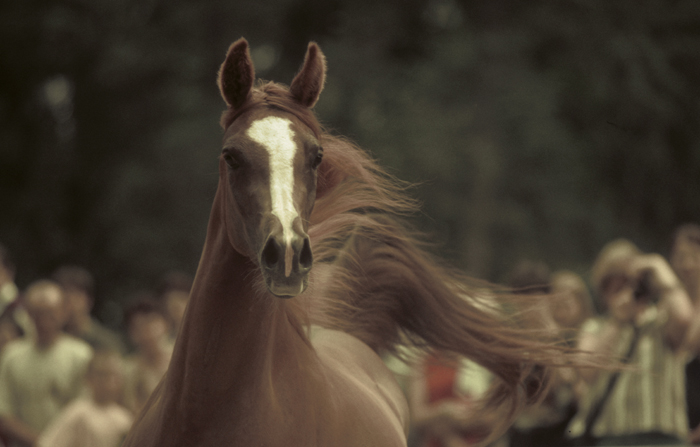
The year of 1994 turned out to be extremely fruitful, because apart from Ekstern and Ganges Polish breeding also greeted Fernando (out of Frejlina by Pepton), who boasted a successful show career in the hands of his owners, Turban Stud from Denmark (twice Danish National Champion, All Nations Cup Reserve Champion, World Top Ten Stallion) and handsome get, mainly at private breeders. Unfortunately he died at the prime age of 14 when on lease to Saudi Arabia. Another stallion that cannot go unnoticed is the grey Dębowiec 1995 (out of Dębówka by Eternit). In Poland this stallion was used on a small scale, only by private breeders. Mr. Grzegorz Ostrowski (St. Roch Arabians), in the 1999 season, bred him, among others, to a Eukalipus mare, which resulted in a very delightful filly, named after a Bob Dylan song – Corina-Corina. Dębowiec found his way to Brazil (Mrs. Lenita Perroy, Haras Meia Lua), where he gained the title of Brazilian National Senior Champion Stallion, International Senior Champion Stallion and Senior Reserve Champion Stallion. His get are also successful on show arenas across the pond. Currently the stallion is owned by Dubai Stud. Other ambassadors of Polish breeding were also other Monogramm sons. The grey Kordelas (out of Kabała by Palas), at first winning on UK arenas, later in the US (for Toskhara Arabians), exhibited high aptitude for sports, claiming many awards in performance classes in the US. As it turned out, he passes these traits onto his get. The chestnut Premier (out of Premiera by Piechur) won the World Top Ten Senior Stallion title at the Salon du Cheval in Paris. Erald (out of Emigrantka by Eukaliptus) was Senior Champion Stallion in Malvern (Midlands Arabian Festival).
Peerless Monogramm daughters led by Kwestura
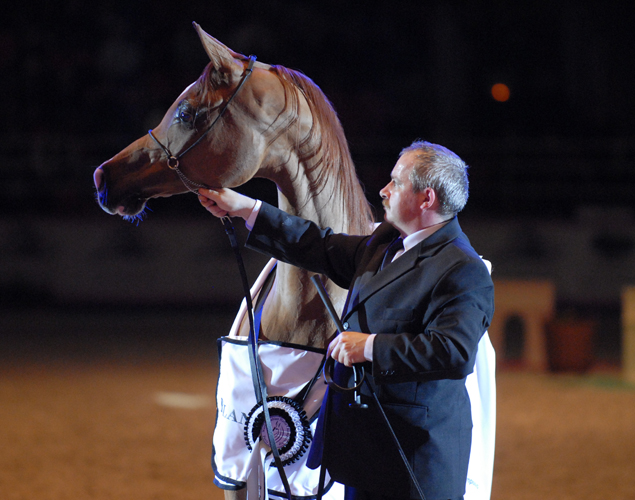
In 2009, together with other fans from Poland, I witnessed the triumph of Monogramm mares in the senior mares‘ class at the All Nations Cup in Aachen. The first five spots were taken by Michałów-bred Monogramm daughters! It was an extremely touching moment for all aficionados of Polish breeding and a confirmation of rightful decisions made by meritorious Polish breeders. Here‘s what I wrote about the event (8*) „The 11-years old and senior mares class seemed to be an absolute culmination of the whole event and the great triumph of Michałów State Stud. 9 participants, 5 of them were Michałów-bred, and all of them found themselves in the head, not giving any chance to their rivals. But what mares they were! Titled, meritorious, and peerless Monogramm daughters: Emmona, Kwestura, Fallada, Elandra and Georgia. The audience almost went crazy with delight, every single mare was cheered on like a real celebrity. The result was incredible, because not only beauty, but also huge money appeared in that moment on the arena. The value of some of those mares is well-known, because the prices that were paid for them are public (Kwestura – 1.125 million Euro, Fallada – 465 thousand, Elandra – one million euro is being said). World Champion Mare 2007 Kwestura and her owner, Sheikh Ammar Bin Humaid from Ajman, was probably convinced that she would win, especially since she impressed everyone by her light, elegant movement. Meanwhile, Emmona entered the arena and something unexpected happened – she floated, full of grace, unavailable for the other horses aking part in this year’s All Nations Cup… She scored five ’20s’ for movement, four ’20s’ for type and one more ’20’ for head and neck. 95,3 points, as it was announced, was the highest result in the show‘s history! The second
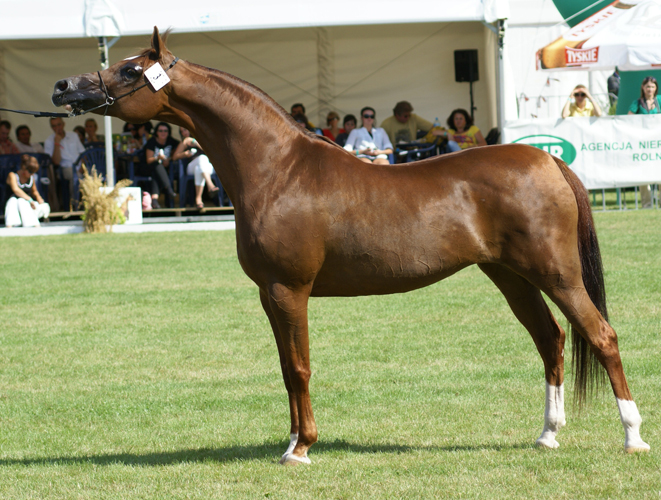
place, somehow unexpectedly, was taken by the 15-years old Georgia (out of Gizela/Palas), with a sensational result of 94,4 points. Kwestura, at third place (94,3), didn’t enter the championship. Fourth place went to Fallada out of Fanaberia/Probat (93,7) owned by NV Zoutekreken/Paul Gheysens (Belgium), fifth – to Elandra out of Erlanda/Eukaliptus (93,4), owned by Halsdon Arabians (GB). This class raised a lot of comments. ’Michałów State Stud didn’t get rid of their most valuable pearls’, people bantered, ’The best ones stayed at home’. The newest show achievement of the today’s 19 year old Kwestura is the title of the All Nations Cup Gold Champion Mare 2014.
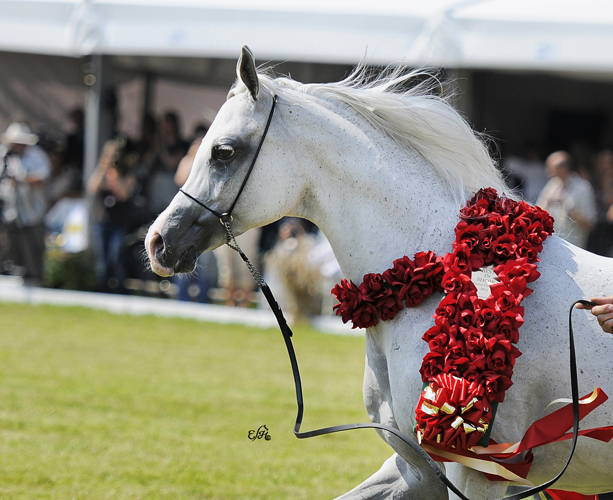
We should recall that Kwestura had been winning since her early years, for instance she won a class at Aachen already as a yearling. Mrs. Urszula Białobok, the main breeder of Michałów Stud who has been working there for 45 years, claims that Kwestura is not an easy horse to show. „Emmona and Emandoria were exceptional from the very beginning. But Kwestura was not“, she says (9*). “Some horses don’t appeal to everyone. My husband and I sometimes have different opinions. I prefer the type of Emandoria or Emmona. In order to notice Kwestura’s uniqueness, you must have a trained eye; not every judge or expert would appreciate her. She is one of those horses that are difficult to judge. But she can perform, she has excellent movement, and there are horses that don’t always want to do it, like Emmona“. However this was not Kwestura‘s final word. As we remember soon after she reached for a second in her career title of World Senior Champion Mare in Paris (2009). „I had a huge sentiment towards Kwestura and I still regret selling her“, admitted Jerzy Białbok (10*) “On the other hand I knew very well that her time had come. And that this time was today and not tomorrow“. Still active at Michałów remain Embra, Emmona, Emocja, Espadrilla, Georgia (dam of Galilea and Georgetown), Palmira and Zagrobla.
A run on Monogramms
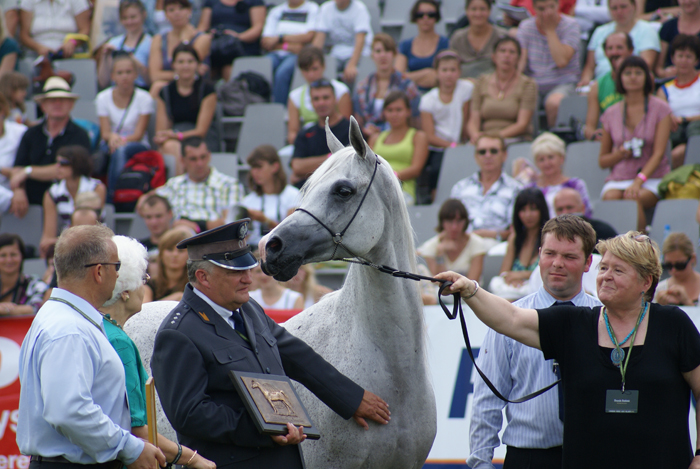
The first of them appeared at the Janów Podlaski sale already in 1996 (Dębołęka and Zalotna). The bids placed in later years oftentimes made heads spin: 2003 – Embella (140 thousand Euro, USA, today in the Middle East) and Figlarka (105 thousand, Brazil); 2004 – Ekscella (120 thousand, USA), Eskalopka (140 thousand, UAE) and Palestyna (300 thousand, USA); 2005 – Elandra (290 thousand, USA, today at Halsdon Arabians, UK); 2006 – Gehenna (180 thousand, Australia); 2007 – Errara (165 thousand, Dubai); 2008 – the afore mentioned Kwestura (1.125 million, UAE), until this day the highest sold horse in the history of the Polish sales; 2009 – Fallada (465 thousand, Belgium).
Convinced about Monogramm daughters value are the following Polish private breeders: Mr. and Mrs. Pietrzak (Minnesota Arabians), owners of the mare Mina (out of Minerwa), the Poszepczyński Family (Chrcynno-Palace Stud), owners of the mare Granada (out of Grenlandia), sold later to the US and Mr. Lech Błaszczyk (Słowianin Stud), owner of the mare Eklezja (out of Erudycja). Also remaining in „private hands“ are Gracja-Bis (Przemysław Sawicki), dam of the highly titled Girlan-Bey, World Junior Champion Stallion of 2005, owned by the Kristofferson Family (Sweden); Gwarka (out of Gratka) of Mr. and Mrs. Wójtowicz (Bełżyce Arabians) and Poruta (out of Premia), who from Zalia Arabians (Poland) found her way to Mrs. Anna Damman (France). All these mares produced valuable progeny, being the pride and joy of their owners.
Purchases made on the Arabian horse market show that Monogramm’s daughters are still a commodity very sought after and what’s interesting, this movement goes both ways. Best Arabians Stud welcomed in 2007 Liza Monelli (out of WC Amarige by Sstanding Ovation) from the US. Her new owner, Mr. Wojciech Parczewski, said: „I have always dreamt of such a mare, a chance at purchasing came about, it would have been a pity to let it slip“. Katarzyna Dolińska of Zalia Arabians imported to Poland from the USA the broodmares Czaparall and Monalisiana (the latter died in 2014).
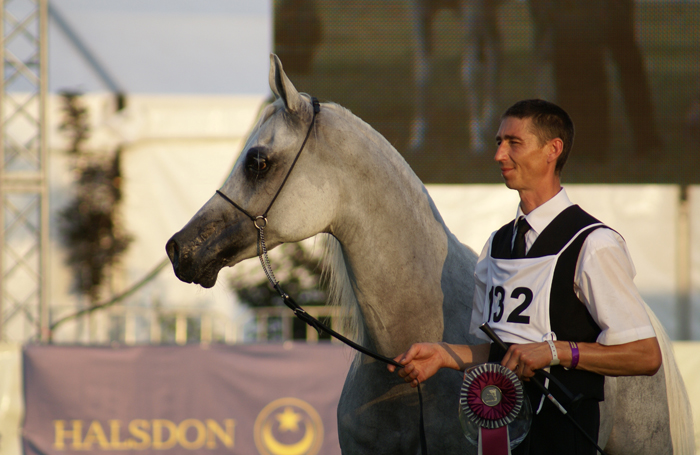
However it is no secret that those bred in Poland, specifically at Michałów, are considered the most valuable. Why did Michałów become such a perfect place for Monogramm? Mrs. Izabella Pawelec-Zawadzka explains: “Monogramm gave horses in various types, that‘s why it was the dams that had a decisive say in the final result. It is no coincidence that Ekstern derives from the most valuable Michałów “E” damline. Monogramm himself was a genetic hybrid. His dam and Negatraz did not suit each other – they were two completely different horses! Monogramma was not a very beautiful mare, you would call her “untypey”. But she was nicely conformed, very correct, with good movement. The Pattersons are one of the most talented breeders. They saw a potential in a mating which wasn‘t immediately obvious. The breeder must sometimes take a risk if he wants spectacular results. Today many matings are arranged because they are fashionable, not because of a detailed analysis of pedigrees of both sire and dam. There are so many breeders in the world who breed to stallions they have never even seen! It‘s pure lottery, not breeding. The successes of Michałów‘s get are also the effect of proper selection. Director Jaworowski left the best specimens in his herd. Seasoned breeders see within a potential sire. They feel whether a given horse will be a chief sire that will make an impact on breeding. Director Jaworowski developed that sixth sense to a magical scale.“
Monogramm was never used at Janów Podlaski, though usually the state studs make use of foreign leases on a similar scale. However Director Andrzej Krzyształowicz did not want to even hear about Monogramm. Mrs. Urszula Białobok recalls: „When I can’t sleep at night, I wonder why Director Krzyształowicz was not convinced and didn’t use Monogramm… this stallion bred practically only at Michałów. While being in the United States I watched beautiful, piebald Monogramm half-breed daughters. I saw one of them at some show, under the saddle, she was fantastically proportioned, had a wonderful color. A great mare. So I said: “Sir, if you don’t want him to cover the Arabian mares, why don’t you cover these piebald ones?“. I heard: “No, he won’t be covering in my stud“. I still wonder why. Because Monogramm had a chestnut color? Or maybe because the director insisted and later it was difficult for him to change his mind. Because Janów Podlaski had at that time some horses that fitted Monogramm better than those Michałów-bred. And if in Michałów the result was excellent, it would definitely only be better in Janów. “
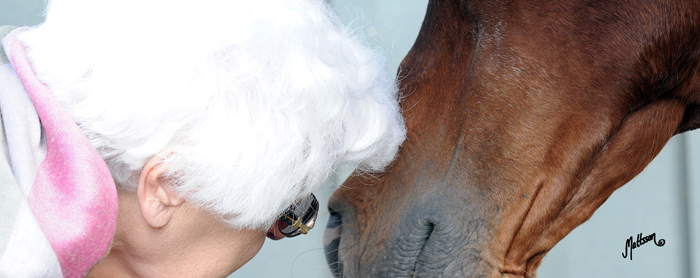
Mrs. Pawelec-Zawadzka recalls: “Director Krzyształowicz as many old time Polish breeders didn‘t like chestnuts. He was a great lover of good conformation, very attached to the sireline of Kuhailan Haifi d.b. but mainly to the bay descendants of this strain. He witnessed the births of the great four sons of Ofir – Witraż, Wielki Szlem, Witeź, Wyrwidąb… Sport, stamina trials for Arabian horses meant a lot to him. And it has to be said that Monogramm did not give “running” get. The only exception was Ganges, but only thanks to his dam from the line of Ofirka. Director Krzyształowicz also didn‘t trust Russian lines. He felt that the breeding in that country was not run the way it should. We must remember that in the USSR after break of World War II there was a lot of chaos and after robbing Polish horses no one had full control over their further use. All this, I think, translated him being opposed to Monogramm.“
President Pawelec-Zawadzka was greatly touched when last year, after a long period, she again saw Monogramm at the stud of the Bishops‘ daughter Shilo, where the stallion is enjoying a much deserved rest. “It was a revisiting of years past, which I recall as being extremely interesting“, she says. “I am happy that I was able to participate in all these Arabian histories. The Bishops have definitely liquidated their stud. Their daughter has a small stable, where till this day stands Monogramm and Concensus, which are doing great. Monogramm is in great shape! He galloped, trotted and simply had fun.“
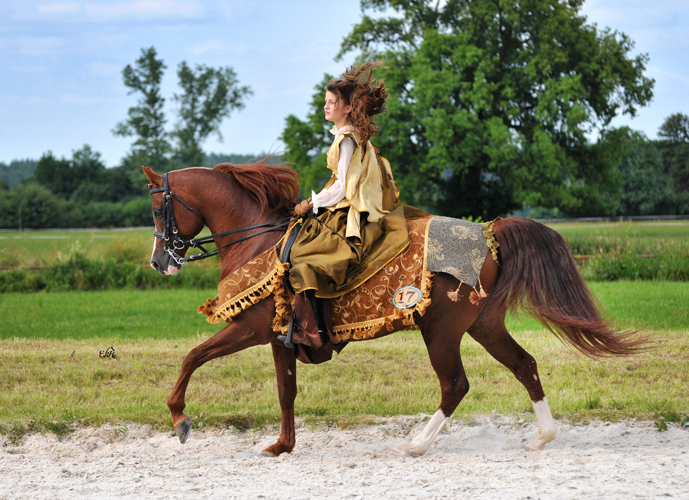
According to Mrs. Pawelec-Zawadzka Monogramm‘s genetic potential was not used in its entirety in the US. One of his best get turned out to be Concensus, sire of the used in Poland Metropolis NA. “The Bishops were very disappointed, because despite Monogramm‘s successes in Poland Americans scarcely bred to him“, she says. “They were discouraged that breeders were not lining up to him. Perhaps Mr. Bishop was not too accessible, perhaps the conditions which he offered were hard to accept. He definitely protected the stallion, didn‘t promote him the way sires are advertised and didn‘t make a lot of noise around him. Besides, in those times information didn‘t spread so easily. Today thanks to the internet everyone knows about everything at once. And back then? The Polish horses had to mature, show themselves at events, in order to let everyone know what a great sire Monogramm was.“
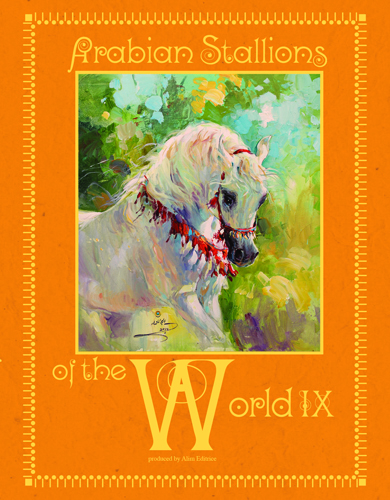
For Director Jerzy Białobok Monogramm remains a dream sire. „I wanted to bring him to Poland twice, something I spoke about with both Mrs. Bishops – mother and daughter“, he said. “Please note that Monogramm’s progeny is practically not present in the US! There are about 3 thousand horses in the Scottsdale show catalogue – and only rarely do we find any Monogramm descendants. He had quite a few problems with reproducing, but we wanted to bring him here for a very good retirement, even without any guarantee for success. His semen was poor, but we were hoping that there would be a chance of success. It’s a pity that this did not come to be, because I think that he would still do great service for Polish breeding. (…) I still dream that I will be able to find a stallion with the positive traits of Monogramm and Gazal Al Shaqab. And on top of that he would be grey. I am still searching.“
———————————————————————————————
1* Tribute to Ignacy Jaworowski, polskiearaby.pl, 2005
2* Koń Polski, no 4
3* Monogramm. His influence on Polish Breeding in 1995-2005, Arabian Horse Days catalogue
4* From stone to dynamite, polskiearaby.pl, 2008
5* Walking in Ekstern‘s shadow – distinguished Monogramm sons born in Poland, polskiearaby.pl, 2008
6* Walking in Ekstern‘s shadow – distinguished Monogramm sons born in Poland, polskiearaby.pl, 2008
7* Canterbury Farm – the story, polskiearaby.pl, 2004
8* Aachen ’09: The Reserve Champion title for Emandoria! But we expected more?, polskiearaby.pl, 2009
9* The company is the most important, polskiearaby.pl, 2009. Mrs. Urszula Białobok‘s remaining quotes also come from this article.
10* Breeding likes no sentiments, polskiearaby.pl, 2008. Director Jerzy Białobok‘s remaining quotes also come from this article.
Text published in the IX edition (2014) of the album „Arabian Stallions of the World“ (Alim Editrice, Italy)
Download the PDF version of the article»


